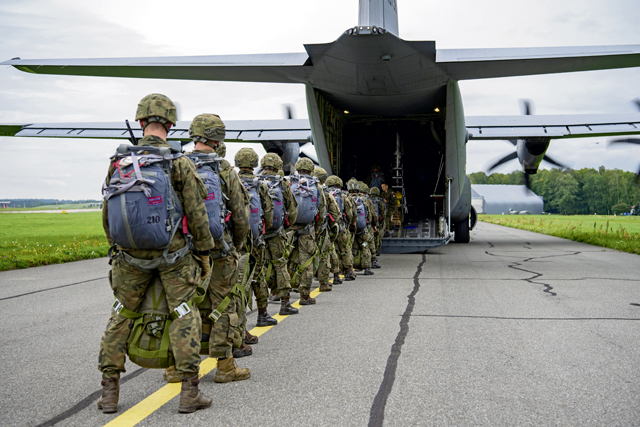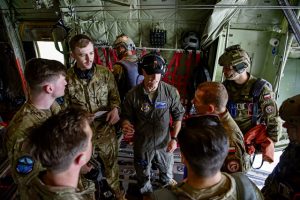
Their demeanor was attentive, patient, and focused as they went through the required safety checks prior to the jump. Each seatbelt was tugged, corrected if needed, then laid crossed on the red chairs. A white rope was dragged along braided metal anchor line cables to check for any deficiencies. When the jumpers boarded the aircraft, eyes looked intently at the rigs on each jumper, while hands tightened and pulled at straps and harnesses.
When safety checks were done, the men and women of the Polish and American military were ready to do what they came there to do – jump from a C-130J Super Hercules cargo aircraft with a parachute.
From beginning to end, the 435th Contingency Response Group jumpmasters ensured all personnel safely jumped and landed on their intended target during Aviation Detachment Rotation 22-4 training in Powidz, Poland, Sep. 13-15.
ADR 22-4 integrated U.S., Polish, German and Italian military, to allow for enhancing the interoperability and airlift capabilities among allied armed forces via realistic joint, air operation scenarios throughout Poland.
As part of the ADR 22-4 training, the 37th Airlift Squadron requested the support of the 435th CRG jumpmasters for three days of scheduled static line air drops, two of which were with the Polish land forces.
The 435th CRG is the U.S. Air Forces in Europe’s only expeditionary open-the-base force to provide a scalable, cross-functional, rapidly deployable force that enables rapid standup of combat operations anywhere in the European Command area of responsibility.
“It was my first time working with foreign jumpers. It was really cool to see how they operate. They work very similarly to how we do,” said Staff Sgt. Jose Gonzalez, 435th CRG jumpmaster. “Obviously, they’re speaking in their own language, but, while watching them I could pick up that the words they were saying were similar to what we say when giving the exact same hand and arm signals.”
Not only were there verbal language barriers, but there are differences between how jumpmasters and aircrew communicate about needs for the mission such as ground operations and visibility.
This communication is essential in ensuring the 435th Air Ground Operations Wing Airmen are able to conduct their mission to integrate airpower at the tactical edge, from the ground up.
“The pilots are on comms with personnel at the drop zone, and anything that would affect the jump I relay to the jumpmaster,” said Airman 1st Class George Alonso, 37th AS loadmaster. “We’re working very fast, but we are focused on making sure the jumps are conducted safely, on time and on target.”
Prior to participating in ADR 22-4, the jumpers’ dedication to their craft began by going through an intense three-week-long course to become a jumpmaster at U.S. Army Garrison Fort Benning, Georgia.

A jumpmaster is a service member who is in charge of every other member conducting a jump for that mission. One of the first tests at jumpmaster school is a five-page document, or pre-jump, which is memorized and repeated verbatim to an instructor, which takes about 15 minutes to recite completely, said Gonzalez.
“Pre-jump goes over what the jumper is supposed to do while in the air,” Gonzalez explained. “Once they exit the aircraft, jumpers run through an entire checklist prior to reaching the ground, like checking their canopy, gaining control of the canopy, and preparing to hit the ground.”
Pre-jump is not just a test to pass, but an essential aspect of the job. Along with a myriad of items to go over during Sustained Airborne Training at Fort Benning, it must be recited prior to every pre-jump procedure a jumpmaster is responsible for.
“Showtime for jumpmasters and those jumping is usually 2-3 hours before boarding an aircraft,” Gonzalez said. “When conducting pre-jump procedures with the jumpers, I have to go over what they do in the aircraft and what they do when they have exited it.”
During that time, they go over sustained exiting, red lighting, jump refusals, towed jumpers, and emergency procedures, or SERJTE. Gonzalez explained that this covers what a jumper should do while inside an aircraft during normal operations and emergency situations.
These physical and mental checks are to ensure the safety of not only those jumping, but aircrew and any other personnel onboard the aircraft.
Over the three days of static line air drops, the 435th CRG jumpmasters clearly demonstrated their respect and love for their job. Gonzalez said the airborne world is the same no matter the language and jump systems.
“It’s a very high-risk activity that we do,” Gonzalez said. “Any airborne operation that goes down without any injuries is a good one.”







